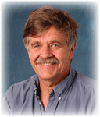PSL Director Awarded Walter Orr Roberts Lecture in Interdisciplinary Sciences
January 16, 2008
 William Neff of NOAA's Earth System Research Laboratories (ESRL) was awarded
the American Meteorological Society's (AMS) 2008 Walter Orr Roberts Lecture
in Interdisciplinary Sciences "for his scientific and programmatic
contributions crossing the boundaries of weather, climate, air quality
meteorology and remote sensing, and for the influence these have had on
public policy affecting air quality." His lecture, entitled, "Learning from
Antarctica: Climate variability and change, stable boundary-layers and
chemistry, and a few surprises on the high plateau," will be presented on
January 23, 2008 at the AMS Annual Meeting in New Orleans, LA.
William Neff of NOAA's Earth System Research Laboratories (ESRL) was awarded
the American Meteorological Society's (AMS) 2008 Walter Orr Roberts Lecture
in Interdisciplinary Sciences "for his scientific and programmatic
contributions crossing the boundaries of weather, climate, air quality
meteorology and remote sensing, and for the influence these have had on
public policy affecting air quality." His lecture, entitled, "Learning from
Antarctica: Climate variability and change, stable boundary-layers and
chemistry, and a few surprises on the high plateau," will be presented on
January 23, 2008 at the AMS Annual Meeting in New Orleans, LA.
Bill is currently the Director of ESRL's Physical Sciences Laboratory. His career at NOAA spans the last 40 years where his accomplishments include studies of acoustic scattering in real atmospheres and meteorological applications; remote sensing in polar regions, remote sensing of complex terrain flows; and applications of remote sensing to air quality. His leadership experience began in the NOAA Environmental Technology Laboratory, first as Chief of the Regional Weather and Climate Applications Division, and later as Laboratory Director. Other honors and awards include the Department of Commerce Silver Medal, two-time recipient of the NOAA Distinguished Authorship Award, the Federal Laboratory Consortium Award for Excellence in Technology Transfer, and the PLAN Boulder County Environmentalist of the Year Award.
Recipients of the Walter Orr Roberts Lecturer Award in Interdisciplinary Sciences are selected in recognition of significant contributions to the understanding of atmospheric processes through the effective interchange of knowledge between atmospheric science subdisciplines or between atmospheric scientists and scientists of other disciplines.
This award is an example of longstanding research excellence at NOAA, and recognizes Bill Neff's cross-cutting, interdisciplinary contributions to NOAA's weather & water, climate, and air quality mission goals. His work has had major impact in air quality policy, polar science, and understanding the critical role of the atmospheric boundary layer in these topics. His innovative approaches include combining unique remote sensing and in situ observations and physics to understand the complex interchanges between the atmosphere and the earth's surface via the boundary layer. Tools and techniques that he has developed are being applied to a broad range of topics across disciplines.
| Contact: Barb DeLuisi | More Information: |